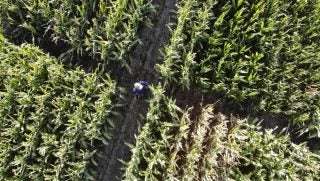An iconic South Dakota bar, dilapidated from eight years of neglect, was reborn last month as an art gallery.
Scrap metal sculptor John Lopez spent months renovating the Kokomo Inn in Lemmon to house his permanent art collection. The unassuming pool-hall bar drew huge crowds from all over both Dakotas for 60 years, becoming an iconic “3.2 bar” during the 1960s, when South Dakota had a drinking age of 18 for places that sold beer with 3.2 percent alcohol or less.
The Lemmon native set his sights on the Kokomo after he installed “Boss Cowman,” a sculpture of the town founder, Ed Lemmon, sitting on a horse, in an empty lot next door. Lopez saw potential in the rotting building, and instead of tearing it down and starting new, he wanted to help locals pay homage to its history. He painstakingly renovated it, replacing its leaking roof, gutting the moldy, mildewy interior and transforming the space into a top-notch gallery.
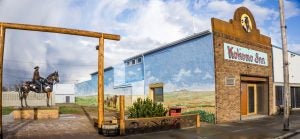
The centerpiece of Lopez’s collection, “The Last Stand,” is the ultimate hybrid metal art sculpture, featuring two warring buffalo emblazoned with cast bronze busts of General Custer on one and medicine man Sitting Bull on the other, telling the story of Custer’s Last Stand.
Lopez grew up in a ranching family, rounding up Angus and Herefords atop their trusty quarter horses. While ranching is in his blood, sculpting and painting are in Lopez’s heart, and he takes inspiration from his background and his hometown’s history in his creations.
That empty lot next door is now a park called Boss Cowman Square, and it still holds Lopez’s sculpture of founder Ed Lemmon. Two Nigerian artists, Dotun Popoola and Jonathan Imafidor, discovered John Lopez’s sculptures online and asked if they could contribute to the project; Lopez has invited the pair to town several times, and they have painted a beautiful, one-of-a-kind mural on the north side of the Kokomo.
The Kokomo Inn now serves as the official gallery of John Lopez sculptures. Dotun Popoola and Jonathan Imafidor’s “Diary of Two Visual Anthropologists” will be the gallery’s maiden exhibition. Visit daily from 10 a.m. to 5 p.m.
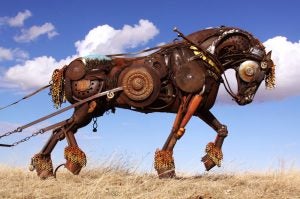
Black Hawk
“Horses like this used to make the world go ’round,” Lopez said.
Prior to the mechanization of agriculture, draft horses shouldered the weight of an industry, fueling its progress and becoming a beloved American icon. They were bred to be muscular, compliant, smart, and loyal. Their farm role entailed working fields, hauling hay, pulling tree stumps, and carrying the family to town to shop. The advent of trains and self-powered equipment eventually phased horses out of most farming operations and transportation needs. That’s why, Lopez said, he chose to weld “Black Hawk” from parts of the same tractors and other equipment that replaced draft horses. This sculpture is an homage both to the horse and to the history of agriculture: The brass bell hanging from the beast’s tail, the charred plow discs, and dozens more actual farming elements that make up its body tell the story of agriculture.
Eastman’s Corner Farm Market near Kensington, New Hampshire, is “Black Hawk’s” permanent home.
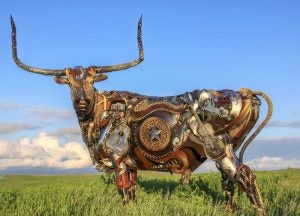
Maverick
Lopez says his family’s cattle herd always included some Longhorn among their typical Angus and Herefords. He drew inspiration for creating “Maverick” from a trip to Austin, Texas, and aimed to integrate Spanish heritage along with music, art and history.
He began with a background of scrap metal and roller chain, then added guitar and fiddle cut-outs and an assortment of Lone Star state symbols. For the horns, he wanted to use an implement that had a natural taper, and thought of just the thing: an old pile of bucket (or bucker) teeth that a friend had given him. “I sliced them like a Slinky and curved them into shape,” Lopez said. (Before the invention of hay balers, farmers attached bucket teeth to the front of a tractor bucket and then lightly dragged the bucket across the ground to collect freshly cut hay.)
“Maverick” is located in the Houston, Texas area.
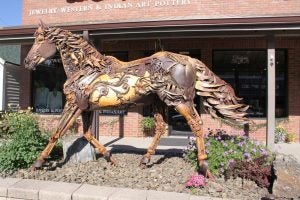
Iron Star
Lopez’s family has long bred quarter horses, a natural fit for a ranching family, and it was only fitting that he pay homage to the steady, sturdy breed in a sculpture. He used the dimensions of a stallion belonging to his uncle Geno, a golden palomino named Frenchman’s Mr. Tuff (still standing at stud at Open Box Rafter Ranch Quarter horses).
He searched his scrap pile for items that would epitomize a graceful mane and tail. He shaped long slices of curved strips of sheet metal using a wire-feed welder, an acetylene torch and a plasma cutter. Then, he formed the forearms, gaskins, and cannons of the horse’s legs by welding on shovels, hand tools, chains, files, barbed wire, western-themed bronze castings and truck shocks.
“Iron Star” now resides in Hill City, South Dakota, purchased for the town by the local arts council.
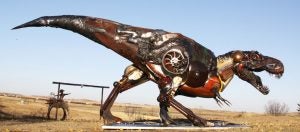
Sue
The largest, most complete and best preserved Tyrannosaurus rex was discovered in 1990 near Faith, South Dakota, an hour from Lopez’s studio in Lemmon. The area’s grasslands and harsh weather make it prime territory for fossil finding, so the largest private fossil preparatory in the world, Black Hills Institute, is located nearby. The corporation’s president, Pete Larson, is also “one of us,” Lopez said, a rancher’s kid who grew up on South Dakota’s Rosebud Reservation. His company excavated Sue, the famous rex which he named after the amateur paleontologist on his team who discovered the bones, Susan Hendrickson.
“When you have one of the world’s T. rex experts just a few hours away, you’d be a fool not to talk to him about the anatomy, posture, and design elements of a sculpture of his favorite subject. So, I invited Pete and his son Matt to visit Lemmon,” Lopez has said. “They brought the unexpected gift of several of the actual tools used to dig Sue 20 years before, along with a cast miniaturization of the original skull of Stan, the second-largest rex ever. Of course, I took great pleasure in distributing these items throughout the body of the sculpture.”
The real Sue fossil was sold in 1997 at Sotheby’s auction house for $7.6 million and is now on permanent exhibition at the Field Museum of Natural History in Chicago. Lopez’s version resides at the Ripley’s Believe It or Not! museum in San Francisco.
